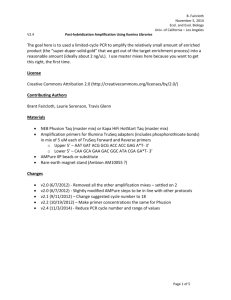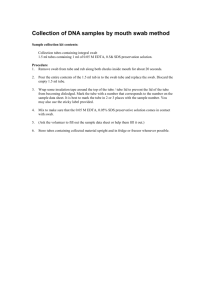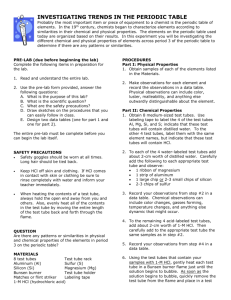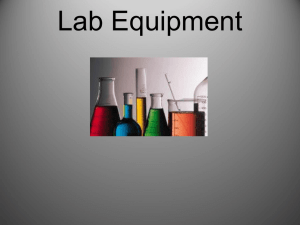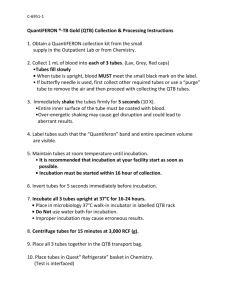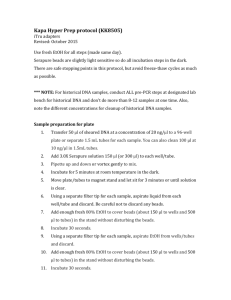B. Faircloth November 28, 2011 Ecol. and Evol. Biology Univ. of
advertisement
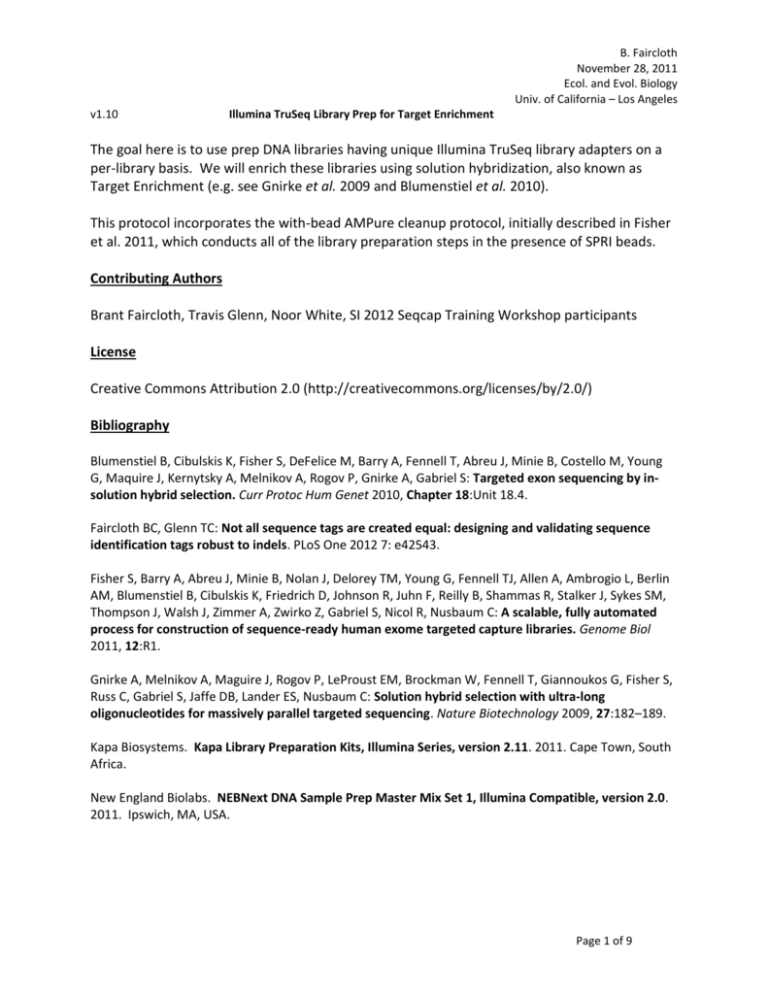
B. Faircloth November 28, 2011 Ecol. and Evol. Biology Univ. of California – Los Angeles v1.10 Illumina TruSeq Library Prep for Target Enrichment The goal here is to use prep DNA libraries having unique Illumina TruSeq library adapters on a per-library basis. We will enrich these libraries using solution hybridization, also known as Target Enrichment (e.g. see Gnirke et al. 2009 and Blumenstiel et al. 2010). This protocol incorporates the with-bead AMPure cleanup protocol, initially described in Fisher et al. 2011, which conducts all of the library preparation steps in the presence of SPRI beads. Contributing Authors Brant Faircloth, Travis Glenn, Noor White, SI 2012 Seqcap Training Workshop participants License Creative Commons Attribution 2.0 (http://creativecommons.org/licenses/by/2.0/) Bibliography Blumenstiel B, Cibulskis K, Fisher S, DeFelice M, Barry A, Fennell T, Abreu J, Minie B, Costello M, Young G, Maquire J, Kernytsky A, Melnikov A, Rogov P, Gnirke A, Gabriel S: Targeted exon sequencing by insolution hybrid selection. Curr Protoc Hum Genet 2010, Chapter 18:Unit 18.4. Faircloth BC, Glenn TC: Not all sequence tags are created equal: designing and validating sequence identification tags robust to indels. PLoS One 2012 7: e42543. Fisher S, Barry A, Abreu J, Minie B, Nolan J, Delorey TM, Young G, Fennell TJ, Allen A, Ambrogio L, Berlin AM, Blumenstiel B, Cibulskis K, Friedrich D, Johnson R, Juhn F, Reilly B, Shammas R, Stalker J, Sykes SM, Thompson J, Walsh J, Zimmer A, Zwirko Z, Gabriel S, Nicol R, Nusbaum C: A scalable, fully automated process for construction of sequence-ready human exome targeted capture libraries. Genome Biol 2011, 12:R1. Gnirke A, Melnikov A, Maguire J, Rogov P, LeProust EM, Brockman W, Fennell T, Giannoukos G, Fisher S, Russ C, Gabriel S, Jaffe DB, Lander ES, Nusbaum C: Solution hybrid selection with ultra-long oligonucleotides for massively parallel targeted sequencing. Nature Biotechnology 2009, 27:182–189. Kapa Biosystems. Kapa Library Preparation Kits, Illumina Series, version 2.11. 2011. Cape Town, South Africa. New England Biolabs. NEBNext DNA Sample Prep Master Mix Set 1, Illumina Compatible, version 2.0. 2011. Ipswich, MA, USA. Page 1 of 9 Changelog 1.1 Change volumes of PEG Solution used during cleanup steps to increase post-shear to 3X and others to 2.2X. Final is 0.9X, which may be a little bit low. 1.2 Alter PEG solution mix to Fisher’s original; Change ddH2O volumes for each step so we don’t have to add water twice. 1.3 Remove all mention of using heat block to dry EtOH from samples. 1.4 Add step telling users to aspirate ddH2O containing DNA after steps 64 and 84. 1.5 Add adapter annealing section. 1.6 Minor wording changes for clarity. Change template volume to 15 uL for Phusion PCR alternative. 1.7 Fix incorrect total volumes for mixes. 1.8 Add in NEB incubation temps, which are slightly different. 1.9 Update instructions for adapters to indicate when you would do this (September 24, 2012). 1.10 Remove Fragmentase info. Change end-repair temp. to 20 C. Page 2 of 9 Materials NEB DNA Fragmentase or Covaris/Bioruptor/etc. for shearing samples. AMPure XP beads or substitute (Serapure) PEG solution mixture (20% PEG, 2.5M NaCl) Rare-earth magnet stand (Ambion AM10055 or NEB S1506S) Kapa Biosystems Library Prep kit (KK8201) or NEBNext Library Prep kit (E6040L) Amplification primers for Illumina adapters (includes phosphorothioate bonds) o Upper 5’ – AAT GAT ACG GCG ACC ACC GAG A*T- 3’ o Lower 5’ – CAA GCA GAA GAC GGC ATA CGA GA*T- 3’ Illumina TruSeq-style adapters (from TruSeq kit or see below) Thermal cycler or ThermoMixer with digital temperature control that will accept 1.5 mL tubes. Alternatively, you can work in 0.2 mL strip tubes or plates and use a standard thermal cycler. SpeedVac (if you need to dry down libraries) Adapters If you are using custom sequencing adapters [i.e., not the standard Illumina TruSeq adapters and something similar to those adapters in Faircloth and Glenn (2012)] and you have ordered both indexed oligos and a universal oligo from IDT, you need make indexed adapters from the indexed oligo + universal oligo. This means combining one indexed oligo with the universal oligo, and annealing those to make double-stranded adapters. You need to do this for all adapters you will use, and it is best/easiest to do this in a PCR plate. 1. Assemble the following components to make Oligo Buffer: 9.9 mL 1X TE (10 mM Tris pH 8.0, 1 mM EDTA) 0.1 mL 5 M NaCl 10 mL Total 2. Using the Oligo Buffer, assemble the following components for to create the adapters: 50 uL Oligo Buffer 25 uL 100 uM TruSeq Universal Adapter 25 uL 100 uM TruSeq Indexed Adapter (e.g. Index 1) 100 uL Total Page 3 of 9 3. Anneal: 95 C for 1 minute -0.1 C/sec for 800 seconds (13.33 minutes) 14 C hold 4. Store adapters at -20 C. Steps 1. Equilibrate DNA samples to ~ 20 ng/uL in 100 uL. 2. Shear DNA to a size distribution peaking around 400-600 bp using a Diagenode BioRuptor or Covaris. 3. Check size distribution on agarose gel (1.5% for 1.5 h at 100 V). If some samples are too large, shear again for 1-2 cycles. 4. Re-quantify using QuBit. Transfer 1 ug sheared DNA to a new tube. 5. Add 3.0X volume of AMPure XP beads to the digested product from Step 4 in a 1.5 mL microtube. Remember, we are altering the standard AMPure protocol by leaving the DNA bound to the beads while we end-repair, +A, and ligate adapters to DNA fragments. Mix by pipetting or gently vortexing. 6. Incubate the mixture for 5 minutes at room temperature. 7. Move 1.5 mL tubes to a rare-earth magnet stand. 8. Let sit for about 3 minutes or until solution is clear. 9. Using a separate filter-tip for each 1.5 mL tube, aspirate liquid from tubes and discard. 10. Add 200 uL 70% EtOH to each tube in the stand. 11. Incubate 30 seconds. 12. Using a separate filter-tip for each 1.5 mL tube, aspirate EtOH from tubes and discard. 13. Add 200 uL 70% EtOH to each tube in the stand. 14. Incubate 30 seconds. 15. Using a separate filter-tip for each 1.5 mL tube, aspirate EtOH from tubes and discard. 16. Allow the tubes containing the AMPure beads to dry for approximately 5 minutes or until there is no longer a smell of EtOH. You do not want the AMPure beads to appear “cracked” or “crusty”. In my experience, it takes about 7 minutes for tubes to air-dry in a low humidity environment. Do not dry on a heat block. Use sterile toothpicks to remove EtOH blobs. 17. Add 85 uL ddH20 to beads and mix gently by inverting or pipetting. Page 4 of 9 18. Assemble the end-repair reaction: 10 uL End Repair Buffer 5 uL End Repair Mix 15 uL Total volume 19. Add 15 uL end-repair reaction mix to tube containing beads and DNA in 84 uL ddH20 (resulting in 100 uL total volume). 20. Pipette up and down to mix. 21. Incubate for 30 m at 20 C (same for NEB reagents). 22. Add 220 uL PEG (2.2X) solution mixture to reaction with beads. Mix by pipetting or gently vortexing. 23. Incubate the mixture for 5 minutes at room temperature. 24. Move 1.5 mL tubes to a rare-earth magnet stand. 25. Let sit for about 3 minutes or until solution is clear. 26. Using a separate filter-tip for each 1.5 mL tube, aspirate liquid from tubes and discard. 27. Add 400 uL 70% EtOH to each tube in the stand. 28. Incubate 30 seconds. 29. Using a separate filter-tip for each 1.5 mL tube, aspirate EtOH from tubes and discard. 30. Add 400 uL 70% EtOH to each tube in the stand. 31. Incubate 30 seconds. 32. Using a separate filter-tip for each 1.5 mL tube, aspirate EtOH from tubes and discard. 33. Allow the tubes containing the AMPure beads to dry for approximately 5 minutes or until there is no longer a smell of EtOH. You do not want the AMPure beads to appear “cracked” or “crusty”. In my experience, it takes about 7 minutes for tubes to air-dry in a low humidity environment. Do not dry on a heat block. You can use sterile toothpicks to remove EtOH blobs and speed drying. 34. Add 42 uL ddH20 to beads and mix gently by inverting or pipetting. 35. Assemble the +A reaction: 5 uL 10X A-tailing Buffer 3 uL A-tailing Enzyme 8 uL Total volume 36. Add 8 uL +A reaction mix to the tube containing beads and DNA in 42 uL ddH20 (resulting in total volume of 50 uL). 37. Incubate for 30 m at 30 C (30 m at 37 C for NEB). Page 5 of 9 38. Add 110 uL PEG solution (2.2X) to reaction with beads. Mix by pipetting or gently vortexing. 39. Incubate the mixture for 5 minutes at room temperature. 40. Move 1.5 mL tubes to a rare-earth magnet stand. 41. Let sit for about 3 minutes or until solution is clear. 42. Using a separate filter-tip for each 1.5 mL tube, aspirate liquid from tubes and discard. 43. Add 200 uL 70% EtOH to each tube in the stand. 44. Incubate 30 seconds. 45. Using a separate filter-tip for each 1.5 mL tube, aspirate EtOH from tubes and discard. 46. Add 200 uL 70% EtOH to each tube in the stand. 47. Incubate 30 seconds. 48. Using a separate filter-tip for each 1.5 mL tube, aspirate EtOH from tubes and discard. 49. Allow the tubes containing the AMPure beads to dry for approximately 5 minutes or until there is no longer a smell of EtOH. You do not want the AMPure beads to appear “cracked” or “crusty”. In my experience, it takes about 7 minutes for tubes to air-dry in a low humidity environment. Do not dry on a heat block. Use sterile toothpicks to remove EtOH blobs. 50. Add 29 uL ddH20 to beads and mix gently by inverting or pipetting. 51. Using separate pipette tips for each sample, add 6 uL of the sample-specific adapter mix (25 uM) to each tube. Remember that adapters are sample-specific. 52. Assemble the adapter ligation reaction: 10 uL 5X Ligation Buffer 5 uL DNA Ligase 15 uL Total volume 53. Add 15 uL ligation reaction mix to the tube containing beads and DNA in 34 uL ddH20 and adapters (to yield total volume of 50 uL). 54. Incubate for 15 m at 20 C (same for NEB). 55. Add 45 uL PEG solution (0.9X) mixture to reaction with beads. Mix by pipetting or gently vortexing. We’re using less PEG solution at this step to help us remove very short fragments. 56. Incubate the mixture for 5 minutes at room temperature. 57. Move 1.5 mL tubes to a rare-earth magnet stand. 58. Let sit for about 3 minutes or until solution is clear. 59. Using a separate filter-tip for each 1.5 mL tube, aspirate liquid from tubes and discard. Page 6 of 9 60. Add 200 uL 70% EtOH to each tube in the stand. 61. Incubate 30 seconds. 62. Using a separate filter-tip for each 1.5 mL tube, aspirate EtOH from tubes and discard. 63. Add 200 uL 70% EtOH to each tube in the stand. 64. Incubate 30 seconds. 65. Using a separate filter-tip for each 1.5 mL tube, aspirate EtOH from tubes and discard. 66. Allow the tubes containing the AMPure beads to dry for approximately 5 minutes or until there is no longer a smell of EtOH. You do not want the AMPure beads to appear “cracked” or “crusty”. In my experience, it takes about 7 minutes for tubes to air-dry in a low humidity environment. Do not dry on a heat block. Use sterile toothpicks to remove EtOH blobs. 67. Add 33 uL ddH20 to beads and mix gently by inverting or pipetting. You may wish to size select following this step but before PCR. 68. Incubate 2-5 minutes at room temp. 69. Move 1.5 mL tubes to a rare-earth magnet stand. 70. Let sit for about 3 minutes or until solution is clear. 71. Using a separate filter-tip for each 1.5 mL tube, aspirate liquid from tubes and transfer to a new, clean tube. 72. Quantify 2.0 uL using QuBit. 73. Setup the following PCR reactions in separate 0.2 mL tubes. You can master mix these for multiple tubes/reactions (see Alternatives section for NEB Phusion): 25 uL 2X Kapa HiFi HS RM 5 uL Primer Mix (5 uM each of TruSeq Forward and Reverse primers) 15 uL Adapter-ligated DNA 5 uL ddH20 50 uL Total volume 74. Cycle using the following. You may need to adjust or optimize cycle number: 98 C for 45 seconds => 16-18 cycles of: 98 C for 15 seconds 60 C for 30 seconds 72 C for 60 seconds => 72 C for 5 minutes => 4 C Page 7 of 9 75. In a 1.5 mL tube, combine PCR product and 90 uL AMPure XP beads (1.8X). Mix by pipetting or vortexing. You may wish to go as low as 50 uL AMPure XP (1.0X) to remove small fragments (< 300 bp). 76. Incubate the mixture for 5 minutes at room temperature. 77. Move 1.5 mL tubes to a rare-earth magnet stand. 78. Let sit for about 3 minutes or until solution is clear. 79. Using a separate filter-tip for each 1.5 mL tube, aspirate liquid from tubes and discard. 80. Add 200 uL 70% EtOH to each tube in the stand. 81. Incubate 30 seconds. 82. Using a separate filter-tip for each 1.5 mL tube, aspirate EtOH from tubes and discard. 83. Add 200 uL 70% EtOH to each tube in the stand. 84. Incubate 30 seconds. 85. Using a separate filter-tip for each 1.5 mL tube, aspirate EtOH from tubes and discard. 86. Allow the tubes containing the AMPure beads to dry for approximately 5 minutes or until there is no longer a smell of EtOH. You do not want the AMPure beads to appear “cracked” or “crusty”. In my experience, it takes about 7 minutes for tubes to air-dry in a low humidity environment. Do not dry on a heat block. Use sterile toothpicks to remove EtOH blobs. 87. Add 23 uL ddH20 to beads and mix gently by inverting or pipetting. 88. Incubate 2-5 minutes at room temp. 89. Move 1.5 mL tubes to a rare-earth magnet stand. 90. Let sit for about 3 minutes or until solution is clear. 91. Using a separate filter-tip for each 1.5 mL tube, aspirate liquid from tubes and transfer to a new, clean tube. 92. Quantify 2.0 uL using QuBit. You may wish to size select at this step to tighten the fragment distribution to your desired range. You need approximately 3.5 uL of 147 ng/uL library (~ 500 ng library) to go into the enrichment, if you are enriching samples on an individual (non-pooled) basis. 93. If you are combining libraries for pooled enrichment, combine 8 libraries together at equimolar ratios to produce 3.4 uL of pooled library at 147 ng/uL. This means that you need to add 62.5 ng of each library to a strip tube and ensure that the volume is 3.4 uL (by adding water if < 3.4 uL or drying down the pools libraries and re-hydrating in 3.4 uL). Page 8 of 9 Alternatives You can use polymerases other than the Kapa enzyme (i.e. Phusion Taq), but no guarantee on performance. You definitely want to use a high-fidelity, proofreading enzyme. We have used Phusion polymerase from NEB successfully: 8.0 uL ddH2O 25.0 uL Phusion Master Mix 2.0 uL Primer Mix (25 uM each) 15.0 uL Template DNA (from Step #71) 50.0 uL Total volume Then cycle: 98 C for 30 seconds => 16-18 cycles of: 98 C for 10 seconds 65 C for 30 seconds 72 C for 60 seconds => 72 C for 5 minutes => 4 C You want just enough cycles to yield the desired final concentration and ideally no more cycles than that (we’re trying to amp. while reducing bias). Page 9 of 9
